Meadow Ln, Haughton Green
George and Henry Sidebotham built this cotton-spinning mill (aka Meadow Mill) alongside the river Tame in 1790.
At first, it was water-powered and the weir that provided the water was constructed across the river a short distance upstream.
George Sidebotham lived near the mill at Haughton Dale House (built in 1713) higher up Meadow Ln. Later, the locality of this house became known as Victoria Place and later James Walton built Haughton Dale Mill School (the Iron School) nearby.
James Walton (1802-1883) of Sowerby, Halifax, Yorkshire, acquired the mill in 1853 and he converted it to a wireworks. He also built an iron extension at its western end. Henceforth, the mill specialised in wire drawing and the manufacture of ‘carding cloth’ for use in carding machines and it became known as James Walton & Sons Ltd. James died at Dolforgan Hall, Kerry, Newtown, Montgomeryshire, on the 5 Nov 1883, aged 80 years.
A carding machine is used to disentangle and intermix fibres, such as cotton or wool, to produce an aligned sheet of wadding suitable for spinning into yarn. This is done by passing fibres between a series of rollers covered with ‘carding cloth’ which is a material embedded with steel wire pins. Carding breaks up the tangled fibres and then aligns them to be parallel to each other.
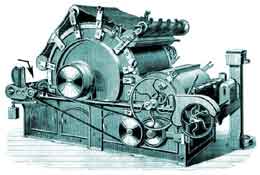
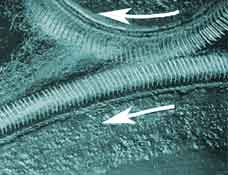
Left: A carding machine. This machine receives raw cotton, say, from a scutching machine (or scutcher) in the form of an unaligned sheet of wadding, known as a ‘lap’,
after it has removed impurities in the cotton, such as seeds. When the carding machine has aligned the ‘lap’ it passes to the roving frame which sets a small amount of twist into it
before it passes to the ring spinning frame or spinning mule that produces yarn ready for weaving.
Right: Detail of two rotating ‘carding cloths’ on a carding machine showing fibres passing between them.
The mill closed on the 12 Mar 1903 and James Walton & Sons Ltd was struck off the Register of Companies in Sep 1904. The date of the demolition of the mill is unknown although by the mid-1930s all the buildings had been demolished to leave little trace of their former existence apart from the lodge and fragments of masonry.
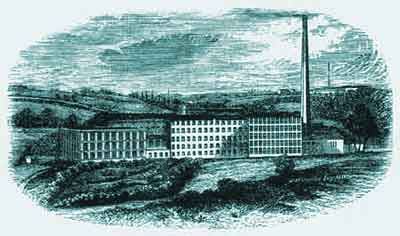 |
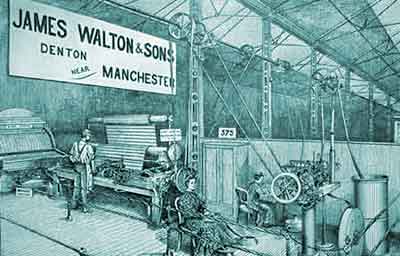 |
An engraving of Haughton Dale Mill, 1884. The mill is seen looking northwards from the Bredbury/Woodley side of the river Tame. At the left-hand end of the mill is James Walton's iron extension and in front of this, on the nearside of the river, are some gardens. The path through these leads to a footbridge over the river that accesses the mill. |
Manchester Royal Jubilee Exhibition, 1887. Engraving of the exhibition stand of James Walton & Sons at the Manchester Royal Jubilee Exhibition. This exhibition was held to commemorate Queen Victoria's Golden Jubilee and it was in the Royal Botanical Gardens at Old Trafford. It was opened by Princess Alexandra, wife of Edward, Prince of Wales, on the 3 May 1887 and it remained open for 166 days. |
 |
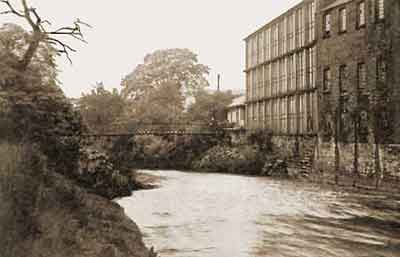 |
Haughton Dale Mill, early 20th century. View of the mill by the river Tame looking upstream (eastwards), clearly showing James Walton's iron extension on the left. Note the footbridge over the river. Below the bridge, at the foot of the mill wall, the exit of the waterwheel tailrace into the river can be seen. |
Haughton Dale Mill, early 20th century. View of the mill by the river Tame looking downstream (westwards). |
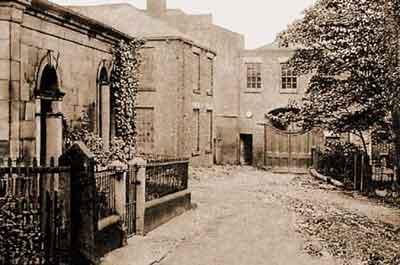 |
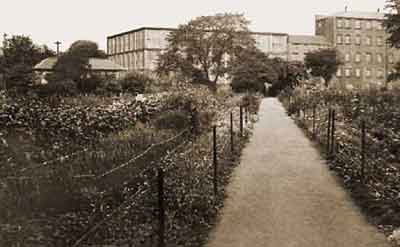 |
Entrance to Haughton Dale Mill, early 20th century. View of the mill entrance from the bottom of Meadow Ln with the lodge on the left. |
Haughton Dale Mill, early 20th century.
View of the mill from the gardens on the Bredbury/Woodley side of the river Tame. The path leads to a footbridge over the river that accesses the mill. This path was of ancient origin and it was on the alignment of the County Boundary between Lancashire and Cheshire. Originally, the plot to the left of the path was in Lancashire and it was known as 'In Haughton' while the plot to the right of the path was in Cheshire (Bredbury/Woodley) and it was a pasture known as 'Nicklebottom'. |
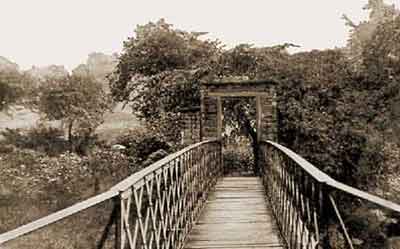 |
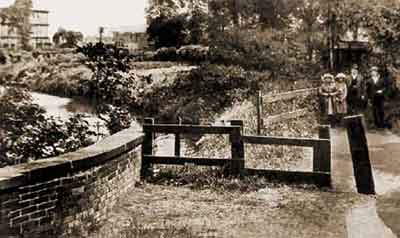 |
Footbridge over the river Tame, early 20th century. View looking towards the gardens on the Bredbury/Woodley side of the river with the mill behind the viewpoint. This footbridge was provided by James Walton to provide a short cut for employees living in Bredbury. It eventually collapsed into the river Tame and the event was reported in the North Cheshire Herald on the 26 Feb 1927. |
Entrance to the gardens, early 20th century. This is the entrance to the gardens from Stoney Croft and Quarry Bank Woods. The bridge in the foreground carries the path over a fast-flowing stream that joins the river Tame at this point. This stream once supplied the power for five mills (three bone mills and two cotton mills). The mill closest to the river Tame was just behind the viewpoint to the right and this was Wood Mill. The Tithe Map of 1841 shows that it was a bone mill but subsequently it was converted to a woollen mill. Behind the four people, the path through the gardens veers to the left. In the top left, the iron extension to the mill can be seen. By the time this photograph was taken the older part of the mill had already been demolished but to the right of the gap, part of the end wall of this is still standing. |
